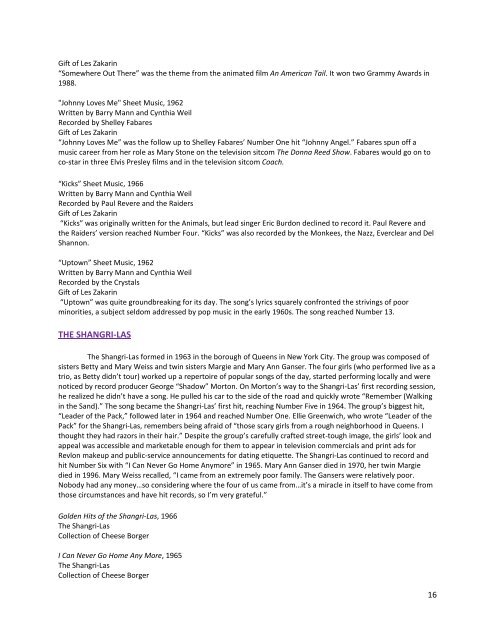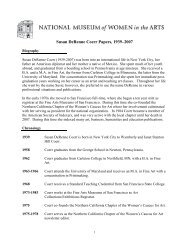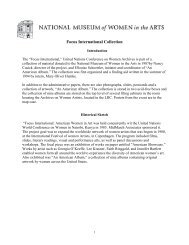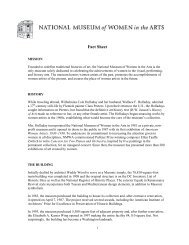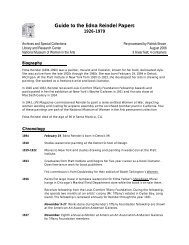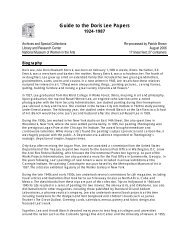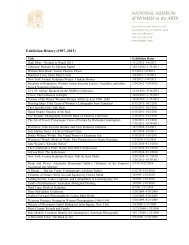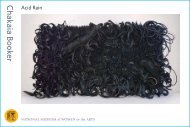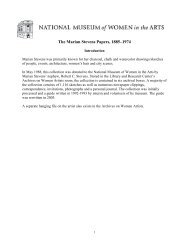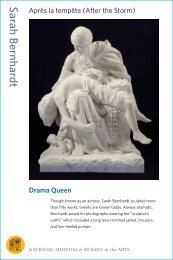LABELS AND TEXT PANELS - National Museum of Women in the Arts
LABELS AND TEXT PANELS - National Museum of Women in the Arts
LABELS AND TEXT PANELS - National Museum of Women in the Arts
You also want an ePaper? Increase the reach of your titles
YUMPU automatically turns print PDFs into web optimized ePapers that Google loves.
Gift <strong>of</strong> Les Zakar<strong>in</strong><br />
“Somewhere Out There” was <strong>the</strong> <strong>the</strong>me from <strong>the</strong> animated film An American Tail. It won two Grammy Awards <strong>in</strong><br />
1988.<br />
"Johnny Loves Me" Sheet Music, 1962<br />
Written by Barry Mann and Cynthia Weil<br />
Recorded by Shelley Fabares<br />
Gift <strong>of</strong> Les Zakar<strong>in</strong><br />
“Johnny Loves Me” was <strong>the</strong> follow up to Shelley Fabares’ Number One hit “Johnny Angel.” Fabares spun <strong>of</strong>f a<br />
music career from her role as Mary Stone on <strong>the</strong> television sitcom The Donna Reed Show. Fabares would go on to<br />
co-star <strong>in</strong> three Elvis Presley films and <strong>in</strong> <strong>the</strong> television sitcom Coach.<br />
“Kicks” Sheet Music, 1966<br />
Written by Barry Mann and Cynthia Weil<br />
Recorded by Paul Revere and <strong>the</strong> Raiders<br />
Gift <strong>of</strong> Les Zakar<strong>in</strong><br />
“Kicks” was orig<strong>in</strong>ally written for <strong>the</strong> Animals, but lead s<strong>in</strong>ger Eric Burdon decl<strong>in</strong>ed to record it. Paul Revere and<br />
<strong>the</strong> Raiders’ version reached Number Four. “Kicks” was also recorded by <strong>the</strong> Monkees, <strong>the</strong> Nazz, Everclear and Del<br />
Shannon.<br />
“Uptown” Sheet Music, 1962<br />
Written by Barry Mann and Cynthia Weil<br />
Recorded by <strong>the</strong> Crystals<br />
Gift <strong>of</strong> Les Zakar<strong>in</strong><br />
“Uptown” was quite groundbreak<strong>in</strong>g for its day. The song’s lyrics squarely confronted <strong>the</strong> striv<strong>in</strong>gs <strong>of</strong> poor<br />
m<strong>in</strong>orities, a subject seldom addressed by pop music <strong>in</strong> <strong>the</strong> early 1960s. The song reached Number 13.<br />
THE SHANGRI-LAS<br />
The Shangri-Las formed <strong>in</strong> 1963 <strong>in</strong> <strong>the</strong> borough <strong>of</strong> Queens <strong>in</strong> New York City. The group was composed <strong>of</strong><br />
sisters Betty and Mary Weiss and tw<strong>in</strong> sisters Margie and Mary Ann Ganser. The four girls (who performed live as a<br />
trio, as Betty didn’t tour) worked up a repertoire <strong>of</strong> popular songs <strong>of</strong> <strong>the</strong> day, started perform<strong>in</strong>g locally and were<br />
noticed by record producer George “Shadow” Morton. On Morton’s way to <strong>the</strong> Shangri-Las’ first record<strong>in</strong>g session,<br />
he realized he didn’t have a song. He pulled his car to <strong>the</strong> side <strong>of</strong> <strong>the</strong> road and quickly wrote “Remember (Walk<strong>in</strong>g<br />
<strong>in</strong> <strong>the</strong> Sand).” The song became <strong>the</strong> Shangri-Las’ first hit, reach<strong>in</strong>g Number Five <strong>in</strong> 1964. The group’s biggest hit,<br />
“Leader <strong>of</strong> <strong>the</strong> Pack,” followed later <strong>in</strong> 1964 and reached Number One. Ellie Greenwich, who wrote “Leader <strong>of</strong> <strong>the</strong><br />
Pack” for <strong>the</strong> Shangri-Las, remembers be<strong>in</strong>g afraid <strong>of</strong> “those scary girls from a rough neighborhood <strong>in</strong> Queens. I<br />
thought <strong>the</strong>y had razors <strong>in</strong> <strong>the</strong>ir hair.” Despite <strong>the</strong> group’s carefully crafted street-tough image, <strong>the</strong> girls’ look and<br />
appeal was accessible and marketable enough for <strong>the</strong>m to appear <strong>in</strong> television commercials and pr<strong>in</strong>t ads for<br />
Revlon makeup and public-service announcements for dat<strong>in</strong>g etiquette. The Shangri-Las cont<strong>in</strong>ued to record and<br />
hit Number Six with “I Can Never Go Home Anymore” <strong>in</strong> 1965. Mary Ann Ganser died <strong>in</strong> 1970, her tw<strong>in</strong> Margie<br />
died <strong>in</strong> 1996. Mary Weiss recalled, “I came from an extremely poor family. The Gansers were relatively poor.<br />
Nobody had any money…so consider<strong>in</strong>g where <strong>the</strong> four <strong>of</strong> us came from…it’s a miracle <strong>in</strong> itself to have come from<br />
those circumstances and have hit records, so I’m very grateful.”<br />
Golden Hits <strong>of</strong> <strong>the</strong> Shangri-Las, 1966<br />
The Shangri-Las<br />
Collection <strong>of</strong> Cheese Borger<br />
I Can Never Go Home Any More, 1965<br />
The Shangri-Las<br />
Collection <strong>of</strong> Cheese Borger<br />
16


